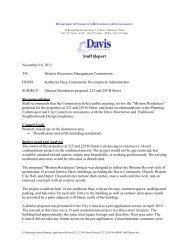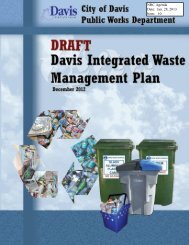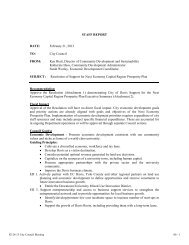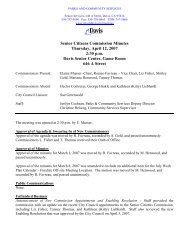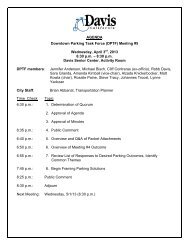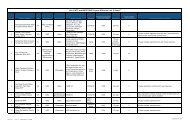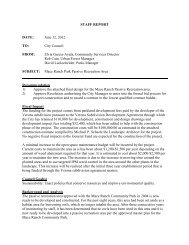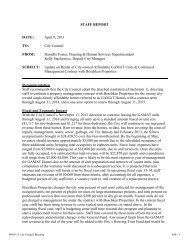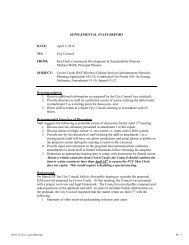06 New Harmony Project - City Council - City of Davis
06 New Harmony Project - City Council - City of Davis
06 New Harmony Project - City Council - City of Davis
Create successful ePaper yourself
Turn your PDF publications into a flip-book with our unique Google optimized e-Paper software.
<strong>New</strong> <strong>Harmony</strong> Apartments – PA#61-07<br />
project. This number takes into account actual meteorological data, actual truck percentages and<br />
other project specific details. It results in a significant difference and a much lower risk. The<br />
HRA results are based on a very conservative scenario that assumes 70-year, 24-hour-a-day<br />
outdoor exposure to pollutants. It is also conservative from a location standpoint and calculates<br />
the risk level at the fence line <strong>of</strong> the <strong>of</strong>fice parcel north <strong>of</strong> Cowell Boulevard at the point closest<br />
to the freeway. When adjusted for location, the risk level from exposure where the residences are<br />
actually proposed falls to about 8.6 in one million. The risk falls even further to 3.1 in one<br />
million when calculated on a more realistic 30-year exposure period. Additional analysis was<br />
conducted on the cancer health risk levels for children at the project site and included additional<br />
parameters specific to children. The results show a carcinogenic risk level <strong>of</strong> 1.9 in one million<br />
for a 9-year exposure period.<br />
The HRA also assessed exposure risk levels for long-term chronic impacts and short-term acute<br />
impacts that include all non-carcinogenic health effects to people including asthma. The chronic<br />
risk <strong>of</strong> 0.010 and acute risk <strong>of</strong> 0.00026 for the project are well below the YSAQMD threshold <strong>of</strong><br />
1.0 for stationary sources. The Southern California health study which found detrimental effects<br />
on the lung development <strong>of</strong> children living near freeways highlights the importance <strong>of</strong> detailed<br />
site analysis. The applicant’s air quality consultant provided additional information and analysis<br />
<strong>of</strong> the study (Attachment 7).<br />
The air quality consultant pointed out that the health study generalizes the health effects as<br />
related to distance from a freeway. Southern California freeways have much higher traffic<br />
volumes, over 300,000 vehicles per day, and a much higher percentage <strong>of</strong> diesel-powered trucks,<br />
as high as 50%, compared to I-80 through <strong>Davis</strong> with 126,000 vehicles per day and about 6%<br />
diesel-powered. Specific conditions and exposure levels can vary dramatically. It is not intended<br />
to minimize the health risks <strong>of</strong> living near freeways. It is already known that exposure to<br />
particulate matter has adverse health effects. Children, the elderly, and those with existing<br />
conditions are most at risk. The HRA results do not directly address the effect on lung<br />
development which is difficult to quantify. It does address asthma and other respiratory<br />
problems. The modeling s<strong>of</strong>tware used in the HRA is made available by the California Air<br />
Resources Board and is the preferred methodology for evaluating health risks from air pollution.<br />
It incorporates site specific information and calculates quantifiable risk levels and comparable<br />
information. It indicates that chronic and acute impacts for the project from exposure to freeway<br />
traffic would be less than significant.<br />
Additional Expert Input<br />
The <strong>City</strong> solicited additional independent analysis from Dr. Thomas Cahill, a nationallyrecognized<br />
air quality expert who has also conducted numerous studies in the <strong>Davis</strong> and<br />
Sacramento region. His analysis and understanding <strong>of</strong> local conditions indicated that the air<br />
quality at the project site would not be expected to be substantially worse than other locations in<br />
the city. The conclusion was based on two main points: 1) prevailing wind conditions favor the<br />
<strong>New</strong> <strong>Harmony</strong> site and would disperse highway pollutants away from the project; and 2) studies<br />
including measurements <strong>of</strong> air quality at the USFS Nursery site in <strong>Davis</strong> which has a similar<br />
distance and location on the south side <strong>of</strong> I-80 as the <strong>New</strong> <strong>Harmony</strong> site indicate relatively good<br />
overall air quality. Dr. Cahill also recommended measures to mitigate impacts and improve<br />
indoor air quality that have been incorporated. The Cahill analysis is included in the Planning<br />
Commission staff report attachments.<br />
10/07/2008 <strong>City</strong> <strong>Council</strong> Meeting <strong>06</strong> - 8



